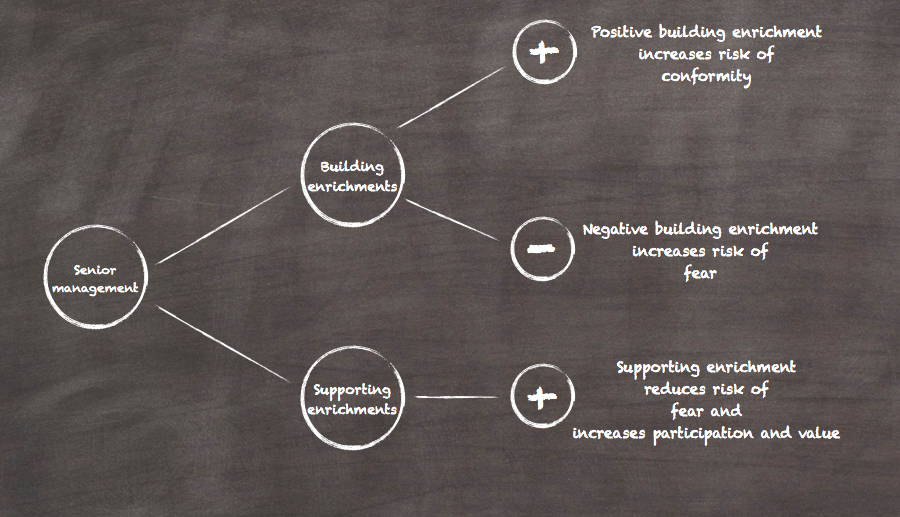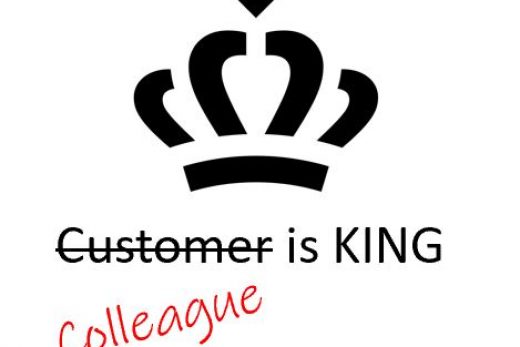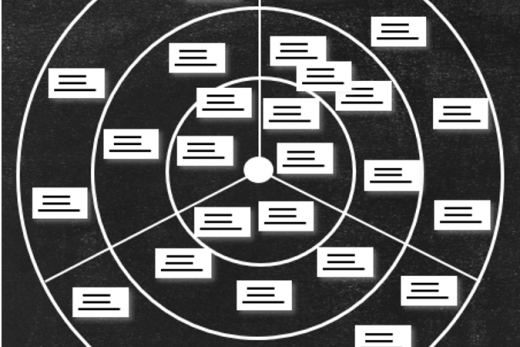
As stated by Jan Martijn Everts in the blog ‘You get what you give’, senior management and sponsorship are important aspects of running successful Idea Challenges. There is no arguing about that. Management support and sponsorship are a necessity for the initiative itself. But should senior management also visibly participate in the online Idea Challenge itself? You would expect that when senior management visibly participates during Idea Challenges, it shows participants that it is OK to participate. We do however sometimes get signals from organizations that think it might have a negative correlation to participation. Some think it is like having Big Brother on the Challenge platform and might scare participants away. Maybe it is not a black and white story but is there more to it.
In contradiction to the situation described above, the principles of brainstorming have been widely researched. Online Idea Challenges are, in principle, like offline brainstorming sessions. What can be learned from this, much researched, method of idea generation.
No management?
One of the brainstorming rules is that leaders should leave their authority outside the room. The senior or boss should behave as any other participant. In a brainstorming session, this is guarded by the facilitator and/or determined by the group of participants. However, this is very hard to do in an online community. The boss will always be the boss no matter how hard he is trying to behave as any other participant due to the transparency of the platform. When the boss is visibly present on the platform, the following could happen. Either participants will be reluctant to share their ideas because of the fear of losing face or they are going to conform to whatever the boss is saying. So, having a senior visibly on the online ideation platform could limit participation and the number of ideas and people might be inclined to share only ideas that the boss might like.
From our experience in Idea Challenges we have seen quite some seniors who have participated in an online Idea Challenge. We have seen seniors asking very tough questions or challenging radical ideas during Idea Challenges resulting in a significant decrease in platform activity. However, we have also seen behavior that significantly increased participation. So, what were the differences between the interaction of the seniors that had such different influence on participation? In order to make this clear you need to make a distinction between two types of enrichments.
Building- and supporting enrichments
There are roughly two types of contributions one can make when participating in ideation sessions or Idea Challenges. The first type is adding knowledge and insights, e.g. submitting an idea and building on ideas by adding relevant knowledge to grow the ideas bigger and better, so-called ‘building enrichments’.
Second, there are the ‘supporting enrichments’ which are the ones that make sure that people feel welcome and result in more ‘building enrichments’ being submitted by different people from within the organization. Supporting enrichments are e.g. showing appreciation to the submitter and enrichers, asking for more elaboration, identifying possible white spots, hooking up knowledgeable people, etc.
Contributing seniors
When seniors contribute with a ‘building enrichment’ the chance is higher that it will have a negative impact on the growth of ideas and participation of the crowd. This is because when the enrichment is positive chances are high the crowd will conform with the boss but when the enrichment is negative, participants will feel fear of participating.
However, when senior management submits a supporting enrichment it will increase participation and growth of ideas because this type of enrichments can only be positive. Due to the character of the enrichment, there is no risk of conformity nor will it create fear. It will reduce the fear of being visible on the platform in the short and long run.

Conclusion
Both proponents and opponents of visible management participation are right. Senior management can indeed kill activity but it can also boost it. It all depends on whether senior management is aware of the effect his or her presence on the online platform may have. In practice we are already very happy if senior management takes the time to participate at all on the platform. We should however make sure that they understand the effects of conformity and fear due to their presence. If they are, they will be more likely to boost participation and activity and eventually grow the value of the platform.
This blog has been written as co-authorship together with Monique Witziers.




Recent Comments